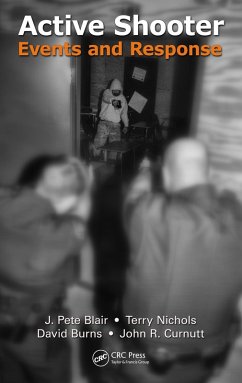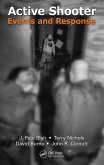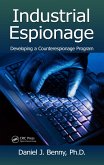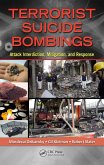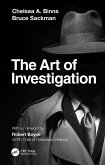John P. Blair, Terry Nichols, David Burns, John R. Curnutt
Active Shooter Events and Response (eBook, PDF)
132,95 €
132,95 €
inkl. MwSt.
Sofort per Download lieferbar

66 °P sammeln
132,95 €
Als Download kaufen

132,95 €
inkl. MwSt.
Sofort per Download lieferbar

66 °P sammeln
Jetzt verschenken
Alle Infos zum eBook verschenken
132,95 €
inkl. MwSt.
Sofort per Download lieferbar
Alle Infos zum eBook verschenken

66 °P sammeln
John P. Blair, Terry Nichols, David Burns, John R. Curnutt
Active Shooter Events and Response (eBook, PDF)
- Format: PDF
- Merkliste
- Auf die Merkliste
- Bewerten Bewerten
- Teilen
- Produkt teilen
- Produkterinnerung
- Produkterinnerung

Bitte loggen Sie sich zunächst in Ihr Kundenkonto ein oder registrieren Sie sich bei
bücher.de, um das eBook-Abo tolino select nutzen zu können.
Hier können Sie sich einloggen
Hier können Sie sich einloggen
Sie sind bereits eingeloggt. Klicken Sie auf 2. tolino select Abo, um fortzufahren.

Bitte loggen Sie sich zunächst in Ihr Kundenkonto ein oder registrieren Sie sich bei bücher.de, um das eBook-Abo tolino select nutzen zu können.
The Columbine tragedy on April 20, 1999 began a new era in law enforcement as it became apparent that the police response to such mass shootings must be drastically altered. By the time the Sandy Hook Elementary School shooting occurred on December 14, 2012, outdated police response strategies had been replaced with new, aggressive tactics used by
- Geräte: PC
- mit Kopierschutz
- eBook Hilfe
- Größe: 4.95MB
Andere Kunden interessierten sich auch für
![Active Shooter Events and Response (eBook, ePUB) Active Shooter Events and Response (eBook, ePUB)]() John P. BlairActive Shooter Events and Response (eBook, ePUB)133,95 €
John P. BlairActive Shooter Events and Response (eBook, ePUB)133,95 €![Foundations of Psychological Profiling (eBook, PDF) Foundations of Psychological Profiling (eBook, PDF)]() Richard BloomFoundations of Psychological Profiling (eBook, PDF)33,95 €
Richard BloomFoundations of Psychological Profiling (eBook, PDF)33,95 €![Industrial Espionage (eBook, PDF) Industrial Espionage (eBook, PDF)]() Daniel J. BennyIndustrial Espionage (eBook, PDF)142,95 €
Daniel J. BennyIndustrial Espionage (eBook, PDF)142,95 €![Terrorist Suicide Bombings (eBook, PDF) Terrorist Suicide Bombings (eBook, PDF)]() Mordecai DzikanskyTerrorist Suicide Bombings (eBook, PDF)61,95 €
Mordecai DzikanskyTerrorist Suicide Bombings (eBook, PDF)61,95 €![The Terrorist-Criminal Nexus (eBook, PDF) The Terrorist-Criminal Nexus (eBook, PDF)]() Jennifer L. HestermanThe Terrorist-Criminal Nexus (eBook, PDF)142,95 €
Jennifer L. HestermanThe Terrorist-Criminal Nexus (eBook, PDF)142,95 €![The CRC Press Terrorism Reader (eBook, PDF) The CRC Press Terrorism Reader (eBook, PDF)]() Marie-Helen MarasThe CRC Press Terrorism Reader (eBook, PDF)109,95 €
Marie-Helen MarasThe CRC Press Terrorism Reader (eBook, PDF)109,95 €![The Art of Investigation (eBook, PDF) The Art of Investigation (eBook, PDF)]() Chelsea A. BinnsThe Art of Investigation (eBook, PDF)45,95 €
Chelsea A. BinnsThe Art of Investigation (eBook, PDF)45,95 €-
-
-
The Columbine tragedy on April 20, 1999 began a new era in law enforcement as it became apparent that the police response to such mass shootings must be drastically altered. By the time the Sandy Hook Elementary School shooting occurred on December 14, 2012, outdated police response strategies had been replaced with new, aggressive tactics used by
Dieser Download kann aus rechtlichen Gründen nur mit Rechnungsadresse in A, B, BG, CY, CZ, D, DK, EW, E, FIN, F, GR, HR, H, IRL, I, LT, L, LR, M, NL, PL, P, R, S, SLO, SK ausgeliefert werden.
Produktdetails
- Produktdetails
- Verlag: Taylor & Francis eBooks
- Seitenzahl: 264
- Erscheinungstermin: 12. Juni 2013
- Englisch
- ISBN-13: 9781466512313
- Artikelnr.: 40066122
- Verlag: Taylor & Francis eBooks
- Seitenzahl: 264
- Erscheinungstermin: 12. Juni 2013
- Englisch
- ISBN-13: 9781466512313
- Artikelnr.: 40066122
- Herstellerkennzeichnung Die Herstellerinformationen sind derzeit nicht verfügbar.
J. Pete Blair is an associate professor of criminal justice at Texas State University and the director of research for ALERRT. Dr. Blair earned his PhD in criminal justice from Michigan State University and his bachelor's and master's degrees in law enforcement and justice administration from Western Illinois University. His current research is focused on active shooter events and best practices. He has published research on a variety of policing issues in numerous journal articles and book chapters.
David Burns has been a deputy sheriff in Texas since 1995 and is one of the founding members of the ALERRT program. He also currently serves as a SWAT team leader, where he has been assigned since 1997. Prior to law enforcement, he served for seven years with the US Army's 82nd Airborne Division and is a veteran of the Persian Gulf War.
Terry Nichols is the assistant director of the ALERRT Center at Texas State University-San Marcos. He retired from the San Marcos Police Department at the rank of commander in January 2010 after serving over 21 years with the department. His last assignment included commanding the Criminal Investigation Division as well as the Hays County SWAT team, where he served for over ten years. Terry worked numerous assignments for the department over his career, including patrol, narcotics, training, and administration. During his tenure in the Training Division, he led the development and creation of the ALERRT Center in San Marcos. He has a BS degree (1991) and an MS degree (1997) from Southwest Texas State University.
John Curnutt has been a police officer in Texas since 1995 and is the director of training for ALERRT. John has been with the training program since the beginning. He is also a SWAT team leader with over 14 years of experience on the team. John's past assignments with his agency include working as a School Resource Officer (SRO) in the patrol division. Prior to law enf
David Burns has been a deputy sheriff in Texas since 1995 and is one of the founding members of the ALERRT program. He also currently serves as a SWAT team leader, where he has been assigned since 1997. Prior to law enforcement, he served for seven years with the US Army's 82nd Airborne Division and is a veteran of the Persian Gulf War.
Terry Nichols is the assistant director of the ALERRT Center at Texas State University-San Marcos. He retired from the San Marcos Police Department at the rank of commander in January 2010 after serving over 21 years with the department. His last assignment included commanding the Criminal Investigation Division as well as the Hays County SWAT team, where he served for over ten years. Terry worked numerous assignments for the department over his career, including patrol, narcotics, training, and administration. During his tenure in the Training Division, he led the development and creation of the ALERRT Center in San Marcos. He has a BS degree (1991) and an MS degree (1997) from Southwest Texas State University.
John Curnutt has been a police officer in Texas since 1995 and is the director of training for ALERRT. John has been with the training program since the beginning. He is also a SWAT team leader with over 14 years of experience on the team. John's past assignments with his agency include working as a School Resource Officer (SRO) in the patrol division. Prior to law enf
Historical Perspective of Active Shooter Events. Specialization of the
Police. The Turning Point. New Response Protocols. Increased Complexity of
Events. The Terrorist Active Shooter Threat. Active Shooter Events in the
United States from 2000 to 2010, WITH M. HUNTER MARTAINDALE. Methodology.
Results. Preparing for the Event. Primary Goals of the Active Shooter
Response. Concept and Principle-Based Training. The Mind-Set of the Modern
First Responder. The Law Enforcement Warrior. On-Scene Leadership and the
Active Shooter Response. En Route and Actions Outside the Building. En
Route. Priorities of Work. Entry and Confronting the Threat. Concepts and
Principles of Team Movement inside a Structure. Room Entry. Improvised
Explosive Devices. Postengagement Priorities of Work. Security. Immediate
Action Plan. Medical. Priorities for Incident Commanders during the "Stop
the Dying" Phase of Response. Civilian Response to Active Shooter Events.
The Role of Civilians during Active Shooter Events. Disaster Response.
Civilian Response to Active Shooter Events. What to Expect When the Police
Arrive. Policy. Appendix. Index.
Police. The Turning Point. New Response Protocols. Increased Complexity of
Events. The Terrorist Active Shooter Threat. Active Shooter Events in the
United States from 2000 to 2010, WITH M. HUNTER MARTAINDALE. Methodology.
Results. Preparing for the Event. Primary Goals of the Active Shooter
Response. Concept and Principle-Based Training. The Mind-Set of the Modern
First Responder. The Law Enforcement Warrior. On-Scene Leadership and the
Active Shooter Response. En Route and Actions Outside the Building. En
Route. Priorities of Work. Entry and Confronting the Threat. Concepts and
Principles of Team Movement inside a Structure. Room Entry. Improvised
Explosive Devices. Postengagement Priorities of Work. Security. Immediate
Action Plan. Medical. Priorities for Incident Commanders during the "Stop
the Dying" Phase of Response. Civilian Response to Active Shooter Events.
The Role of Civilians during Active Shooter Events. Disaster Response.
Civilian Response to Active Shooter Events. What to Expect When the Police
Arrive. Policy. Appendix. Index.
Historical Perspective of Active Shooter Events. Specialization of the
Police. The Turning Point. New Response Protocols. Increased Complexity of
Events. The Terrorist Active Shooter Threat. Active Shooter Events in the
United States from 2000 to 2010, WITH M. HUNTER MARTAINDALE. Methodology.
Results. Preparing for the Event. Primary Goals of the Active Shooter
Response. Concept and Principle-Based Training. The Mind-Set of the Modern
First Responder. The Law Enforcement Warrior. On-Scene Leadership and the
Active Shooter Response. En Route and Actions Outside the Building. En
Route. Priorities of Work. Entry and Confronting the Threat. Concepts and
Principles of Team Movement inside a Structure. Room Entry. Improvised
Explosive Devices. Postengagement Priorities of Work. Security. Immediate
Action Plan. Medical. Priorities for Incident Commanders during the "Stop
the Dying" Phase of Response. Civilian Response to Active Shooter Events.
The Role of Civilians during Active Shooter Events. Disaster Response.
Civilian Response to Active Shooter Events. What to Expect When the Police
Arrive. Policy. Appendix. Index.
Police. The Turning Point. New Response Protocols. Increased Complexity of
Events. The Terrorist Active Shooter Threat. Active Shooter Events in the
United States from 2000 to 2010, WITH M. HUNTER MARTAINDALE. Methodology.
Results. Preparing for the Event. Primary Goals of the Active Shooter
Response. Concept and Principle-Based Training. The Mind-Set of the Modern
First Responder. The Law Enforcement Warrior. On-Scene Leadership and the
Active Shooter Response. En Route and Actions Outside the Building. En
Route. Priorities of Work. Entry and Confronting the Threat. Concepts and
Principles of Team Movement inside a Structure. Room Entry. Improvised
Explosive Devices. Postengagement Priorities of Work. Security. Immediate
Action Plan. Medical. Priorities for Incident Commanders during the "Stop
the Dying" Phase of Response. Civilian Response to Active Shooter Events.
The Role of Civilians during Active Shooter Events. Disaster Response.
Civilian Response to Active Shooter Events. What to Expect When the Police
Arrive. Policy. Appendix. Index.
